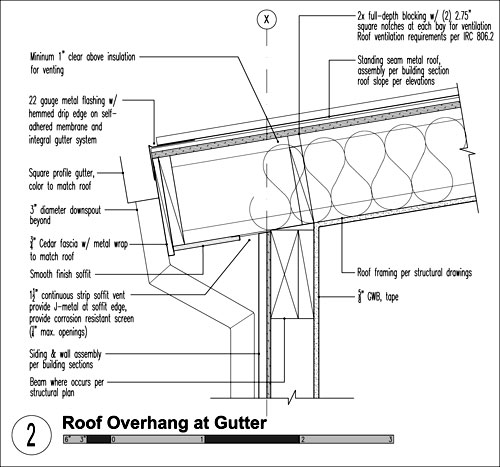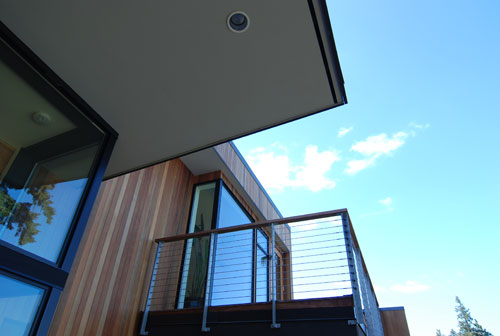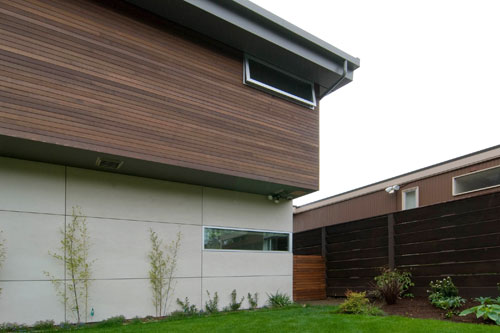
Yes, today’s post is on <geek alert> roof venting. We know, we know, how dull right? Well, not exactly. Being familiar with the building code and knowing how to translate it appropriately and cleverly is what allows architects to create that seamlessly clean look synonymous with modernism. A few simple moves with the framing and soffit design can allow a cost-effective detail to take on an aesthetic of high-end modernism and keep the roof vented all in one fell swoop.

There are many ways to vent a residential roof. Filter the possibilities down to those that meet the current building code requirements along with those that make practical sense in the Pacific Northwest climate and you’re left with a handful of details. Test those remaining details out with the functionality and philosophy of modernism and you’re left with just a few good roof venting details. Today’s post illustrates the detail we’ve come to rely on over years of designing, building, testing and implementing. Here’s a breakdown of our roof venting logistics and why we’re big fans of this detail:
The most important factor of a roof venting detail is that it works well. While this seems like an obvious one, we’re constantly amazed at how many roof venting details we come across that don’t work. The detail should allow an adequate amount of air to realistically circulate through the roof joist bays –entering on one side of the roof and exiting on the other. The venting requirement is a simple calculation of 1 square foot of required venting for every 150 square feet of roof area –a more detailed explanation, along with some exceptions, can be found in the IRC 806.2. We achieve this through a continuous venting strip along the roof eave – this provides more than enough “void-space” for the air to access the roof cavity. The calculation really comes into play with the blocking inside the roof. Structurally, it’s ideal to have 2x blocking extend from the bottom of the joist bays to the top –thereby making a connection between the roof sheathing and the shearwall below. The calculation is used to determine the size and frequency of notches at the blocking. The notches are located at the top of the blocking to confine the air circulation to the void above the insulation. All the blocking at the roof requires this notching so that there is a clear path of travel between opposite eaves.

Maintenance (or the lack thereof) is the second most important factor to us. Timeless design involves just as much function as it does aesthetics and the detail outlined here requires little to no maintenance over time.
The third most important factor is that the means of venting should visually disappear. The continuous venting strip blends in with the lines of the house and diverts attention away from the nature of it being a vent. The venting assembly includes a wire mesh to keep the bugs out; this mesh is typically painted black so that the composition looks like a shadow line. Although we end up with more venting area than we actually need at the eaves, we find that this method is more successful at disappearing than using individual penetrations that would actually add up to less venting area. The clean, unobtrusive geometry created by the continuous venting strip meets the criteria of a modern aesthetic.

Ease of construction is the fourth consideration. As good as a solution might be on paper, if the framers and siders can’t implement it in a straight-forward manner on site, it’s not much use to us. The success of the continuous venting strip typically comes down to a simple detail and good communication on site. Once the crews understand the clean look and direct function that we’re trying to achieve it’s usually a no-brainer to carry out.
The cost-effectiveness of the assembly isn’t necessarily last on our list, but rather it’s a direct result of the success of the previously mentioned attributes. The ease of understanding and implementing this detail on site has a direct correlation with its cost.
There you have it, hit that comments button and get your two cents in.
For more geek-speak follow us on Twitter.






